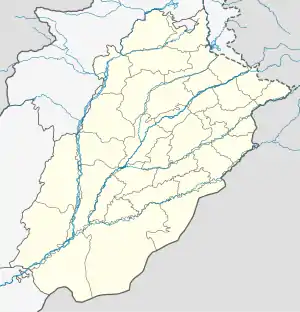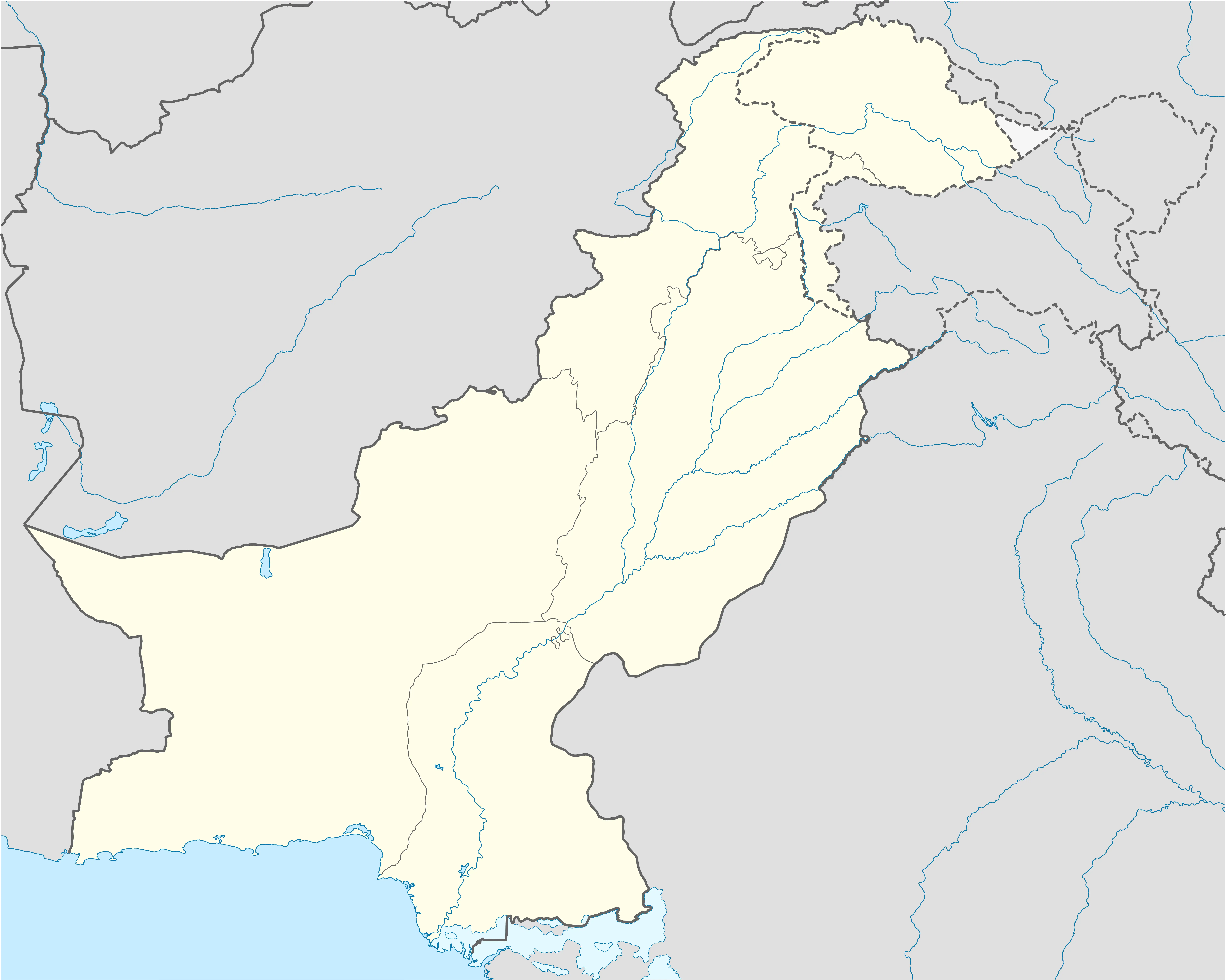Mananwala
Manawala (Urdu: مانانوالہ) is a city in Sheikhupura District, Punjab, Pakistan. It is situated on the Lahore-Sheikhupura-Faisalabad road.[1]
Mananwala
مانانوالہ | |
|---|---|
City | |
 Mananwala Location in Pakistan  Mananwala Mananwala (Pakistan) | |
| Coordinates: 31°35′15″N 73°41′23″E | |
| Country | Pakistan |
| Province | Punjab |
| District | Sheikhupura |
| Union Councils | UC.-100/1 |
| Postal Code | 39170 |
| Area | |
| • Total | 9 km2 (3 sq mi) |
| Population (2013) | |
| • Total | 50,000 |
| • Density | 5,600/km2 (14,000/sq mi) |
| Time zone | UTC+5 (PST) |
| Area code | 056 |
History
Prior to the Partition of India, Mananwala was established by and belonged to the famous Jat Sikh Mann Sardars of Mughalchak, Gujranwala. Initially consisting of five large Havelis within a fortified perimeter,[2][3][4] Mananwala has now expanded into a sizeable city of more than 9 square kilometres and with a population of over 50,000 people. In reference to this family, Lepel H. Griffin footnotes that "there is a saying, well known in the country, to the effect that three families in the Panjab, Attariwala, Mann, and Majithia, have possessed the greatest number of remarkable men. The Attariwala Sardars are brave and faithless. The Mann Sardars, handsome, gallant and true; the Majithias, wise and timid.”[5]
Hari Ram Gupta accounts that in mid-eightheenth century, in order to establish and strengthen the Sukerchakia Misl, Charat Singh made four major matrimonial alliances, one of which was made with the Mann Sardars of Mughalchak.[6] Sardar "Charat Singh's son Mahan Singh was married to the daughter of Sardar Jai Singh Mann of Mogalchak".[7] Sardar Jai Singh Mann[8] was the Sardar of the Mughalchak Misal,[9] and led his forces alongside Sardar Charat Singh, the Sardar of the Sukerchakia Misl, in the military expeditions of Tsa Khel, Pindi Bhattiari, Gujrat, and Sialkot.[10][11] Sardar Jai Singh Mann, with his younger brothers, Sardar Nar singh Mann, Sardar Mana Singh Mann, and Sardar Pahar Singh Mann, also marched with his forces to Jammu with Sardar Maha Singh when in 1780 the Sukerchakia and Mogalchak forces defeated Raja Brij Raj Deo.[12] The union of marriage between the Sardar Charat Singh's son and Sardar Jai Singh Mann's daughter helped unite Mogalchaks and Sukerchakias, keeping in line with sardar Charat Singh's bid to strengthen the Sukerchakias misal.[13] Other key matrimonial alliances made by Sardar Charat Singh were as with the Sardars Sohel Singh and Sahib Singh of the Bhangi Misl, and Sardar Dal Singh of Akālgarh.[14]
Lepel H. Griffin records that the Mann Sardars were very powerful and continued to hold great prestige and fame even after the rise of Maharaja Ranjit Singh, with "at one point there were no fewer than twenty-two members of it holding key military appointments of great trust and honour".[15] Griffin further articulates that Maharaja Ranjit Singh "often used to say that the Man Sardars were his "Wari Ka Tewar"," interpreted by Griffin as either 'the jewels of his court' or 'his best suit of clothes'.[16]
The Mann Sardars were very much at the centre of, and fought both the Anglo-Sikh Wars between 1845 and 1849. General S. Rattan Singh Mann and Sardar Kahn Singh Mann led their own brigades of artillery, infantry and cavalry during the battles of Sobraon, Ferozeshah, Mudki, and Aliwal.[17] A letter during the Second Anglo-Sikh War was intercepted by Captain James Abbott, the Assistant Resident, on deputation to Huzara, on 16th August 1848 from Sardar Chattar Singh Attariwalla to Sardar Budh Singh Mann in which Sardar Chhatar Singh stated that "I raised this mutiny in the name of the family of Maun" [18]
The Mann Sardars of Mughalchak and Mananwala have several recognised cadet branches which are the once powerful houses of Bhagga under Sardar Amar Singh Mann, Ramnagar, Malwa, Manawala in Amritsar, and include Sardar Kahn Singh Mann.[19] Denzil Ibbetson notes that “the ‘mirasis’ or bards of the Mán Sardars of Mughalchak-Mananwala state that the whole of the Mán, Bhular and half the Her tribe of Rajputs were the earliest kshatriya immigrants from Rajputana to the Punjab. Due to which, the Mán, Bhúlar, and Her tribes (section 435) are known as the asl or ‘original’.”[20]
See also
References
- "Mananwala". maplandia.com. Archived from the original on 2016-03-04.
- "Mananwala History" (in Punjabi). Punjabi Lehar. 11 July 2017. Retrieved 6 April 2021.
- "Mananwala Haveli Sahib Singh" (in Punjabi). Yaadan 1947 Diyan. 18 August 2019. Retrieved 6 April 2021.
- "Mananwala Havelis" (in Punjabi). Yaadan 1947 Diyan. 19 October 2019. Retrieved 6 April 2021.
- Griffin, Lepel H. (1865). The Punjab Chiefs. Historical and Biographical Notices of the Principal Families in the Territories Under the Punjab Government. Lahore: T.C. McCarthy,-Chronicle Press, 1865. p. 91.
- Gupta, Hari Ram. History of the Sikhs. Vol. IV: Sikh Commonwealth or Rise and Fall of the Misls. Munshiram Manoharlal Publishers, 1982. p. 304. ISBN 978-8121501651.
- Gupta, Hari Ram. History of the Sikhs. Vol. IV: Sikh Commonwealth or Rise and Fall of the Misls. Munshiram Manoharlal Publishers, 1982. p. 304. ISBN 978-8121501651.
- "Moghalchak". Jat Chiefs. 2020. Retrieved 9 Jan 2022.
- Hoti, Prem Singh. Khalsa Raj de Usraiyye. Lahore, 1942.
- Griffin, Lepcl. The Punjab Chiefs. Lahore, 1865.
- "Jai Singh Man". The Sikh Encyclopaedia. 19 October 2019.
- McGregor, W.L. The History of the Sikhs. [Reprint] Patiala, 1970.
- Prinsep, Henry T. Origin of the Sikh Power in the Punjab and Political Life of Maharaja Ranjit. Singh. Calcutta, 1834.
- Gupta, Hari Ram. History of the Sikhs. Vol. IV: Sikh Commonwealth or Rise and Fall of the Misls. Munshiram Manoharlal Publishers, 1982. p. 304. ISBN 978-8121501651.
- Griffin, Lepel H.; Massey, Charles Francis (1910). Chiefs and Families of Note in the Punjab: A Revised Edition of "The Punjab Chiefs," Sir Lepel H. Griffin, K.C.S.I., and of "The Chiefs and Families of Note in the Punjab," by Colonel Charles Francis Massey, Indian Staff Corps The Punjab Chiefs. Historical and Biographical Notices of the Principal Families in the Territories Under the Punjab Government. Lahore: Revised and Corrected, under the orders of the Punjab Government by W. L. Conran, Major, Indian Army, and H. D. Craik, Indian Civil Service, Civil and Military Gazette Press, 1910. pp. 105–106.
- Griffin, Lepel H.; Massey, Charles Francis (1910). Chiefs and Families of Note in the Punjab: A Revised Edition of "The Punjab Chiefs," Sir Lepel H. Griffin, K.C.S.I., and of "The Chiefs and Families of Note in the Punjab," by Colonel Charles Francis Massey, Indian Staff Corps The Punjab Chiefs. Historical and Biographical Notices of the Principal Families in the Territories Under the Punjab Government. Lahore: Revised and Corrected, under the orders of the Punjab Government by W. L. Conran, Major, Indian Army, and H. D. Craik, Indian Civil Service, Civil and Military Gazette Press, 1910. p. 111.
- Singh, Amarinder Singh (2011). The Last Sunset: The Rise and Fall of the Lahore Durbar. Delhi: Roli.
- "Journals And Diaries Of The Assistant To The Agent, Government -general North-west Frontier And Resident At Lahore 1846-1849". Internet Archive. Retrieved 21 Feb 2023.
- Griffin, Lepel H.; Massey, Charles Francis (1910). Chiefs and Families of Note in the Punjab: A Revised Edition of "The Punjab Chiefs," Sir Lepel H. Griffin, K.C.S.I., and of "The Chiefs and Families of Note in the Punjab," by Colonel Charles Francis Massey, Indian Staff Corps The Punjab Chiefs. Historical and Biographical Notices of the Principal Families in the Territories Under the Punjab Government. Lahore: Revised and Corrected, under the orders of the Punjab Government by W. L. Conran, Major, Indian Army, and H. D. Craik, Indian Civil Service, Civil and Military Gazette Press, 1910. pp. 105–106.
- Ibbetson, Denzil (1916). Panjab Castes. Lahore: Printed by the Superintendent, Government Printing, Punjab. p. 119.